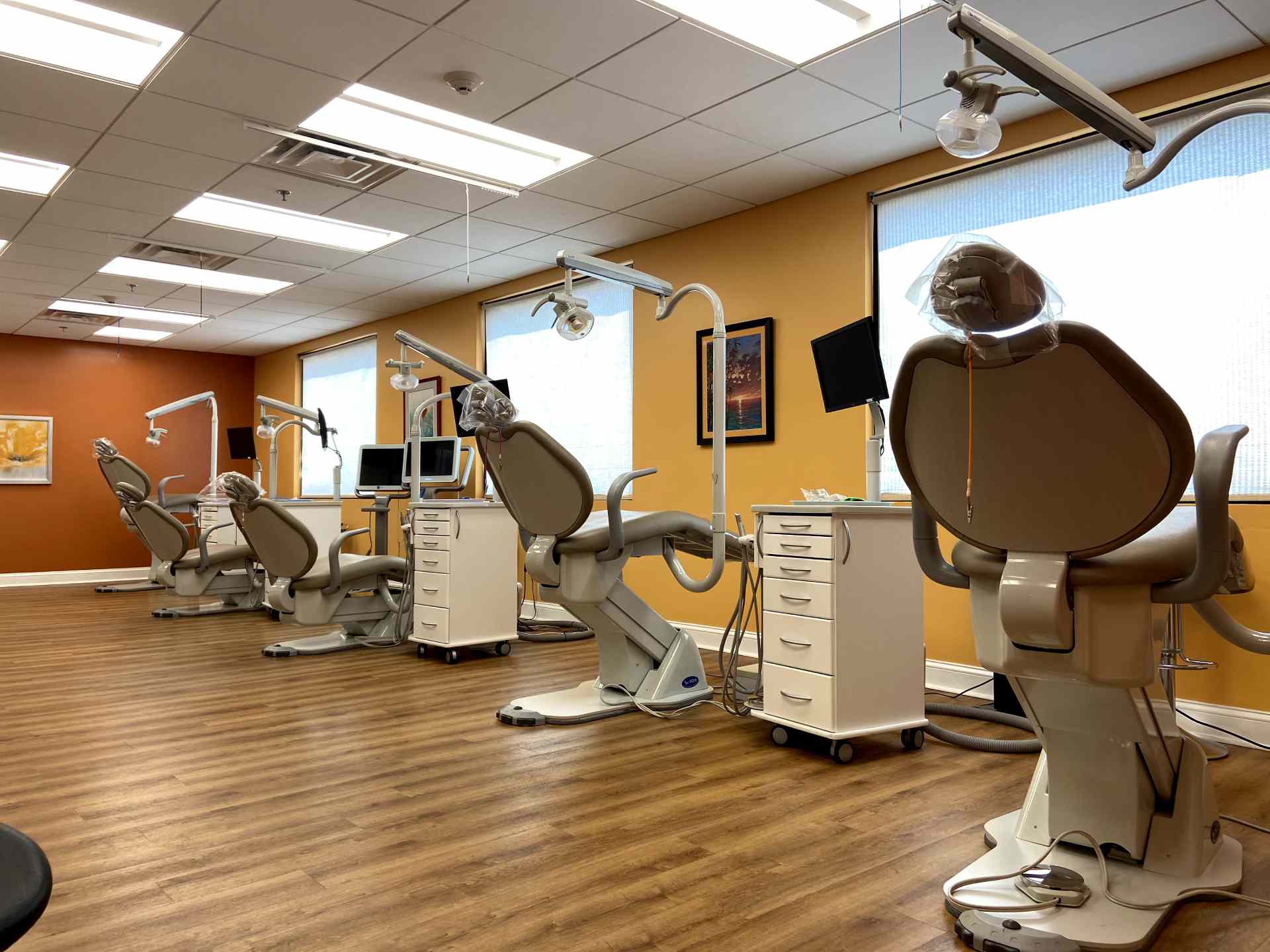TMJ/TMD Treatment
It Affects More Than Your Mouth
If you are one of the millions of Americans suffering from chronic face or neck pain, recurring headaches or migraines, ringing in the ears, popping or clicking jaw sounds, muscle spasms, lockjaw, or even vertigo — you may have TMD (temporomandibular disorder).
This is a condition affecting the TMJ, or the joints responsible for connecting your lower jawbone to your skull that act similarly to hinges. Responsible for helping us chew, talk, yawn, and swallow, these joints are an important part of our everyday lives that often go unnoticed. However, to a person suffering from the symptoms of TMD, their presence is always known. General pain and discomfort can be temporary, or ongoing, and affect one or both sides of the face. More common in women than men, TMD can arise at any time, but most frequently, it becomes a problem between the ages of 20 to 40.
Symptoms can include, but are not limited to:
- Pain in the jaw area
- Pain, ringing, or stuffiness in the ears
- Frequent headaches or neck aches
- Clicking or popping sounds when the jaw moves
- Swelling on the sides of the face
- Muscle spasms in the jaw area
- Locked jaw or limited opening of the mouth
- A change in the alignment of the top and bottom teeth
Even if you are not experiencing TMD symptoms, there are simple steps you can take to prevent problems in the future such as:
- Avoid grinding your teeth and gum chewing.
- Relax your face, and remember the rule: “Lips together, teeth apart!”
- Chew food evenly on both sides of your mouth.
- Practice good posture with your head up, back straight, and shoulders squared.

Botox & Fillers
At ARCH, we’re more than just an orthodontic practice. We believe that a beautiful smile goes beyond straight teeth. That’s why we offer a range of aesthetic treatments, including Botox (Botulinum Toxin) and dermal fillers, to help our adult patients achieve the confident, radiant smiles they deserve. As an AAFE (American Academy of Facial Esthetics) certified and trained practice, we are equipped with the necessary skills and knowledge to safely administer these treatments.
These services are available at our Westwood location on Fridays and Saturdays by appointment.
Botox
Best known for its ability to smooth facial wrinkles, Botox offers a host of benefits for dental aesthetics and oral health. Botox can dramatically enhance your smile by addressing a ‘gummy smile,’ a condition where excessive gum tissue is visible when smiling. By carefully administering Botox to relax hyperactive upper lip muscles, we can minimize gum visibility, creating a more balanced and attractive smile.
In addition to aesthetic enhancements, Botox is a powerful tool in treating Temporomandibular Joint Disorders (TMD). By targeting and relaxing the overactive jaw muscles, Botox can alleviate common TMD symptoms such as jaw pain, headaches, and bruxism (teeth grinding).
Dermal Fillers
Dermal fillers work hand-in-hand with our orthodontic treatments to rejuvenate your smile. Age-related volume loss can lead to sagging skin and pronounced nasolabial folds. With the strategic application of fillers, we can restore lost volume, soften facial lines, and lend a youthful glow to your smile. Additionally, fillers can enhance lip volume, providing a fuller, well-defined shape that beautifully complements your aligned teeth.
Both Botox and fillers are minimally invasive procedures performed in-office, requiring no downtime. While results are temporary, they typically last between three to six months for Botox and six to eighteen months for fillers, depending on individual factors and the specific product used.
As an AAFE-certified and trained practice, patient safety and satisfaction are our top priorities. Our team possesses the expertise and training to deliver Botox and filler treatments with precision and care, ensuring optimal results.
At ARCH, we believe in comprehensive smile enhancement. Botox and fillers, coupled with our advanced orthodontic solutions, offer a powerful combination to help you achieve the radiant, confident smile you’ve always desired. Contact us today to learn more about these services and how they can enhance your orthodontic journey.

Airway Orthodontics
At ARCH, we believe in a holistic approach to oral health. We understand that orthodontic care extends far beyond aesthetics — it’s deeply connected to your overall well-being. This understanding fuels our focus on Airway Orthodontics, a ground-breaking field that marries dental science with airway function.
What is Airway Orthodontics?
Airway Orthodontics is an innovative approach that underscores the vital role of the mouth, jaw, and tongue in maintaining a clear and functional airway. It goes beyond merely straightening teeth to promote proper oral posture, which can greatly impact your breathing patterns.
Incorrect jaw and tongue posture can lead to a narrow palate, misaligned teeth, and a restricted airway, resulting in a series of health challenges. Airway Orthodontics aims to address these issues at their root, fostering healthier oral and overall body function.
The Benefits of Airway Orthodontics
By encouraging correct oral posture and alignment, Airway Orthodontics can help alleviate a range of conditions including sleep apnea, Temporomandibular Joint (TMJ) disorders, snoring, and breathing difficulties.
Sleep apnea, a condition characterized by interrupted breathing during sleep, can be significantly improved through Airway Orthodontics. By expanding the palate and adjusting the position of the jaw and tongue, we can create a more spacious airway, reducing instances of sleep apnea.
Similarly, TMJ disorders, often linked to improper jaw alignment and function, can be addressed by correcting the jaw position. This not only relieves TMJ symptoms but also promotes better breathing.
Interestingly, Airway Orthodontics can also have a positive impact on conditions such as ADHD and anxiety. These conditions are often associated with poor quality sleep and breathing difficulties, and by improving airway function, we can mitigate some of these challenges.
Furthermore, the improved oxygen flow resulting from a clear airway leads to better overall health, improved concentration, enhanced sleep quality, and increased energy levels.
At ARCH, we view orthodontic treatment as an opportunity to enhance not just your smile, but your entire health profile. Through Airway Orthodontics, we strive to improve your quality of life by addressing the root causes of various health issues, rather than just treating the symptoms. With a team of skilled professionals, we’re ready to guide you on your path to better health through improved oral posture and airway function.

Sleep Apnea Treatment
Break the Cycle of Bad Sleep — Sleep Better, Live Better
A good night’s sleep keeps us alert and able to function throughout our busy day. But when refreshing rest becomes elusive and a constant struggle to achieve, our health and the well-being of our bed partners and family can suffer.
Obstructive sleep apnea (OSA) can sometimes be to blame. OSA is a severe form of Sleep Disordered Breathing. This troublesome condition affects more than twelve million Americans and can breathing to stop hundreds of times each night. Each time this occurs, there’s a lapse in oxygen being supplied to the brain causing patients to temporarily wake up to restart proper breathing. Most patients don’t even remember this happens, but wake up feeling fatigued on a regular basis.
What are the Signs?
Common sleep apnea signs include:
- Loud snoring
- Waking up with shortness of breath and headaches
- Falling asleep unintentionally during the day
- Extreme drowsiness
- Insomnia and difficulty sleeping
Who Does Sleep Apnea Affect?
While many think sleep apnea occurs only in heavy-set adults, this myth is false. Sleep apnea can also be a problem for both children and adolescents. Unfortunately, it can lead to a higher rate of attention-related issues such as hyperactivity and attention disorders (ADHD/ADD), aggressiveness, problems focusing in school, and emotional distress. We can help address and treat sleep apnea in young patients to ensure a healthy, happy future.
There are a wide variety of sleep apnea treatments available, but how they’re used depends on the complexities of an individual case. Common behavioral changes can suffice, but sometimes bite guards and CPAP machines are necessary. If you or someone in your family is plagued by sleep issues, talk to us about how we can help. We depend on a sleep specialist for diagnoses; once confirmed, your ARCH doctor can provide a small, effective inside-the-mouth appliance to correct the apnea problem.

Two-Phase Treatment
When it comes to our younger patients, we recommend along with the American Association of Orthodontists to bring children to the orthodontist for an evaluation by the age of seven. By that age, the first permanent molars and incisors should have already begun erupting and should be visible inside the mouth. Issues like dental crossbites or crowding can be assessed at this point and should be treated appropriately before they become truly problematic.
The trained orthodontists of ARCH are highly skilled in their specialty of Dentofacial Orthopedics. We guide and direct facial bone growth for proper harmony between the top and bottom jaws, this enables better tooth movement and alignment. This treatment is most effective at an early age when the bones are responsive to gentle pressure. Because an ARCH orthodontist helps guide the growth of a child’s jaws, the best foundation for the incoming permanent teeth is created. This helps to achieve the correct space for permanent teeth, potentially avoiding the need to extract permanent teeth in the future. Early orthodontic checkups can also address airway issues and poor or abnormal facial development, leading to impaired respiration, mouth breathing, and sleep apnea issues. Dentofacial orthopedics can help control and correct possible breathing/respiratory issues along with reducing the likelihood of impacted teeth, correct thumb-sucking, and address abnormal swallowing or speech problems.
Is Two-Phase Treatment Necessary?
Corrective dentofacial treatment often involves expanders and other advanced appliances designed to achieve balance in facial bones and jaw structure. A future second phase of treatment involving braces may also be needed to perfect contacts or movements between teeth.
Some children will benefit from two-phase treatment, a very specialized approach that combines tooth straightening and facial bone correction. ARCH orthodontists are experts in this. We have over 25,000 completed happy patients with over one hundred and fifty years of cumulative experience brought to you or your loved ones. Two-phase treatment typically begins before all of a child’s permanent teeth have erupted, while their jaw is still “soft” and growing. The first phase of treatment directs the growth relationship of the upper and lower jaw, establishing a foundation for incoming permanent teeth and possibly preventing the need for tooth removal and/or surgical intervention. In the second, later phase of treatment, the adolescent’s permanent teeth are moved into proper alignment, creating beautiful harmony with the lips, cheeks, tongue, and other teeth.

Dentofacial Orthopedics
For Balance & Structure — Setting Things Straight With Oral Appliances
We have a specialization in orthodontics and dentofacial orthopedics. While most patients are familiar with how orthodontic techniques are used to straighten teeth, dentofacial orthopedics is a less commonly understood, but highly effective treatment.
As practitioners of dentofacial orthopedics, ARCH orthodontists are able to focus on the guidance of growth and development of facial bones to help assist healthy tooth movement. This process mainly occurs during early childhood, but the treatment can be adapted for adults too.
How Does the Treatment Work?
This form of treatment involves the use of appliances such as Occluso-guides, Night-guides, and Habit appliances as a means of addressing abnormalities or deficiencies in both the facial bone and jaw structure. Dentofacial orthopedics are also often used either in preparation for further orthodontic treatment or in conjunction with braces. One of the greatest things about many of these appliances is that they are usually worn only at home and/or are hardly noticeable…other than the incredibly positive effect they have on the growth and development of the patient.
Since Dentofacial orthopedics involves developing bones of those who are younger in order to maximize space, as well as coordinate jaw discrepancies, (as opposed to tooth discrepancies), we often use expansion appliances to widen the palate, as well as the lower teeth. In some cases, we use a “Reverse Pull Headgear” to enhance the forward jaw growth of the upper jaw, when it is lagging behind the lower, or the lower is growing faster than the upper.

Common Appliances
Appliances for Precise Orthodontics
Orthodontists use a variety of appliances and techniques to achieve desired results that contribute to the overall effectiveness of treatment. While most are aware of braces, which are considered a type of appliance, other specialized dental devices can be added to a patient’s treatment plan. These devices or appliances are often needed to prepare the teeth or jaw for braces, or used in conjunction with orthodontic movement using braces. In all cases, it is important to follow your doctor’s instructions for use and care. We are experts in giving the information needed to use our appliances; but, cooperation from you, the patient, is the key factor in achieving the most effective and efficient treatment.


